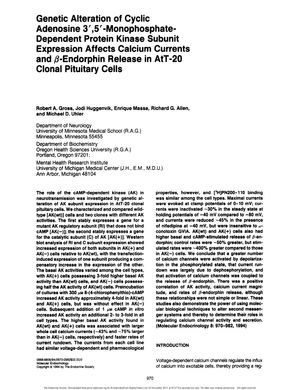Genetic alteration of cyclic adenosine 3',5'-monophosphate-dependent protein kinase subunit expression affects calcium currents and beta-endorphin release in AtT-20 clonal pituitary cells.
August 1994
in “Molecular Endocrinology”

TLDR Changing protein kinase levels in pituitary cells affects calcium flow and beta-endorphin release.
The study from 1994 explored how altering cyclic adenosine 3',5'-monophosphate-dependent protein kinase (AK) subunit expression in AtT-20 clonal pituitary cells affects calcium currents and beta-endorphin release. The researchers created cells with varying AK activity: AK(wt) with normal activity, AK(-) with reduced activity, and AK(+) with increased activity. They discovered that cells with higher AK activity had larger calcium currents and a faster rate of current rundown, as well as increased basal and cAMP-stimulated beta-endorphin release. The AK(+) cells showed the highest calcium currents and the fastest current rundown, while AK(-) cells had the lowest. The study concluded that AK activity is positively correlated with calcium channel activity and beta-endorphin release, suggesting that phosphorylation of calcium channels is crucial in these processes.
View this study on academic.oup.com →